Country Report: Denmark and Sweden
On the Northern fringes of Europe, those who want to believe that there is a sustainable future for the old continent's generous healthcare systems find a beacon of hope.
This sponsored supplement was produced by Focus Reports.
Project Coordinator: Alina Manac, Aleksandra Klassen
Editorial Coordinator: Herbert Mosmuller
Project Publisher: Julie Avena
Contribution: Mary Carmen Luna Matuk
For exclusive interviews and more info, please log onto www.pharmaboardroom.com or write to contact@focusreports.net

Ãresund bridge HDR, HÃ¥kan Dahlström
On the Northern fringes of Europe, those who want to believe that there is a sustainable future for the old continent's generous healthcare systems find a beacon of hope.
At a time when the healthcare systems of most of the European Union's member states are going through their biggest existential crisis in post-war history, the Nordics (Denmark, Finland, Iceland, Norway, and Sweden) maintain sustainable yet technologically advanced healthcare systems.
Furthermore, the region's most populous nations (and the focus of this report), Sweden and Denmark, have made impressive contributions to the world's life sciences industry.
Denmark, a country of 5.6 million, brought the world such pharmaceutical champions as Novo Nordisk, Lundbeck, Leo Pharma, and ALK. Sweden, population of 9.5 million, grooms a thriving life sciences industry while its pharmaceutical market, the largest in the region, is often considered the barometer of Europe due to its progressive nature.
Denmark and Sweden coming out on top amid fierce competition, despite their modest populations, is often ascribed to the 'Nordic model.' This slightly undefined concept refers to a consensus-based model with a focus on sustainability and high levels of trust and cooperation between government and industry. Is the 'Nordic model' really the key explanation behind the remarkable success of the Danish and Swedish life sciences industry?
MAKING A VIRTUE OF NECESSITY?
"The Nordic region—the 'quiet North' as it could have been called—counterbalances the turbulence in Southern Europe," said Zinta Krumins, managing director Nordics, Boehringer Ingelheim, when asked about the relevance of the Nordics to the company. "The Nordics are a very stable region, with small but reasonable growth prospects, very good government structures and frameworks, social infrastructure and a solid economy."

Zinta Krumins, Managing Director Nordics, Boehringer Ingelheim
Although attractive for their stable economies and governments, the Nordics do not have numbers on their side. "We cannot compete in terms of volume and economy of scale," said Stig Jørgensen, CEO of Medicon Valley Alliance, a network organization representing human life sciences in Medicon Valley, a region spanning eastern Denmark and south-western Sweden.

Stig Jørgensen, CEO, Medicon Valley Alliance
Thus, the countries need to work together in order to increase their leverage. "Other countries often have an individualistic mindset and their culture revolves around competing with each other," Jørgensen continued. "Our collective culture enables us to unite doctors, engineers, and business people to work together. All these disciplines collaborating and working in the same domain is where innovation will flourish."

Dorthe Mikkelsen, Senior Vice-President Mid-Europe 2, MSD
With Sweden and Denmark taking spot one and three respectively on the European Commission's Innovation Union Scoreboard 2013, it is hard to argue against the effectiveness of the model.
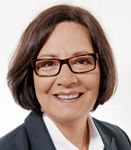
Mary Di Marzio, General Manager Nordics, Shire Plc
For instance, both Sweden and Denmark are overrepresented in clinical trials. MSD conducts about 10 percent of all its clinical trials in the Nordic region. "The attractiveness of the Nordics is a health care system that is state of the art, with strong medical professionals, a high level of scientific leaders both at the universities and at the clinics, and an overall strong infrastructure for clinical research," said Dorthe Mikkelsen, Senior Vice-President Mid-Europe 2, MSD. Furthermore, the Nordics offer a good data foundation. "Their registries are a goldmine for doing research and developing new products," Mikkelsen said.
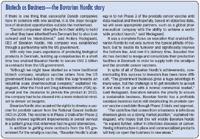
Biotech as Business-the Bavarian Nordic story
Clinical trials are also seen as another avenue for innovation, with many companies breaking out of the traditional sales model. "We see clinical trials as a positive way to collaborate with health care professionals," Tommy Söderman, general manager Nordics, IPSEN, said. "In the Nordics we have many of our own initiatives; for example, we are running clinical trials on rehab patients recovering from strokes at 30 sites in the Nordic region."

Pia Olsen Dyhr, Minister of Trade & Investment, Denmark
The two countries are also a goldmine for acquisitions. Shire Plc recently acquired Swedish biotech Premacure, a biotech developing a therapy for the prevention of retinopathy of prematurity, currently in Phase II.

Christian Dyvig, CEO, Lundbeck Foundation
"Before Premacure became part of Shire, the company was already surrounded by an environment that allowed them to invest, explore and discover, which we then found was a good fit for us. Sweden provides an environment in which government incentivizes companies to be innovative and rewards innovation with favorable taxation," said Mary Di Marzio, General Manager Nordics with Shire Plc. "That is at the core of what the Nordic nations are encouraged to do and are rewarded for doing."

Anders Hedegaard, CEO of Bavarian Nordic
DENMARK: A LAND FLOWING WITH MILK AND PHARMA
How has a nation of a modest 5.6 million been able to build a pharmaceutical industry that exported medicinal products worth USD10.1 billion (DKK58 billion) in 2011? "It is a historical success born through partnership between the industry and the Danish government," said Minister of Trade & Investment Pia Olsen Dyhr.
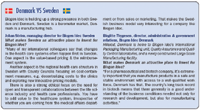
Denmark VS Sweden
"Novo Nordisk, for example, benefits from the government's decision to give all patients with diabetes access to free medication. The company has hence been able to build on the domestic market before going global. In the same way, Lundbeck and Leo Pharma benefitted from Public-Private Partnerships to build an export business."
Another shared characteristic of Denmark's top pharmaceutical companies is that they are controlled by foundations. As majority owner, the foundation usually decides who sits on the board, monitors corporate activities, and helps whenever the companies need support, including financial backing for acquisitions. "This model has a lot of potential for innovation and the development of new drugs, something we couldn't do to the same extent if we were just focused on what the stock market wanted us to do," said Lundbeck Foundation CEO Christian Dyvig. The Lundbeck Foundation owns 70 percent of Lundbeck's shares and is majority owner of ALK, a supplier of allergy immunotherapy products with a global market share of approximately 33%.
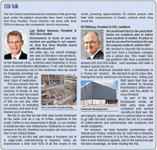
CEO-Talk
Can the absence of the stock market as a reality check lead subsidiaries to get too comfortable where they are?
"That is a risk," Dyvig said. "Academic articles on foundations describe the notion of the dead hand. An owner with a dead hand loses dynamism in the business. That's one of the reasons that we like our companies to be stock listed. The duality between the long-term nature of the foundation and the short-term nature of the stock market brings a lot of benefit. It is in that friction that you end up having the best results."
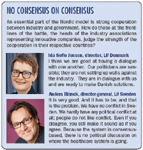
NO CONSENSUS ON CONSENSUS
PUSHING AND PULLING
Most stakeholders in the Danish and Swedish life-sciences industry praise the outcome of concerted efforts to set up the right pull-factors for innovation—the framework to enable pharmaceutical research to flourish. Finding consensus over the push-factors—government's willingness to pay for new innovative products to be used by the healthcare system—is much more challenging.
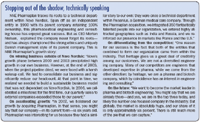
Stepping out of the shadow, technically speaking
In Sweden Government spending on academic research has increased significantly even throughout the economic crisis, and in October 2012, the government put forward its Research and Innovation bill, under which USD 600 million will be spent between 2013-2016 to boost Swedish research capabilities. One of the bill's six focus areas is the life sciences industry.
At the same time, Sweden may soon link its existing value-based pricing system with international reference pricing to cut drug expenditures. The pharmaceutical industry warns this change would have an adverse effect on both the attractiveness of Sweden as a market and as a location for R&D activities.
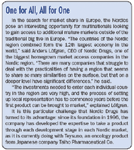
One for All, All for One
"The focus is solely on the push-part of the business," said Anders Blanck, director-general of Swedish pharma industry association LiF. "The government wants to build the infrastructure for a well-functioning life-science sector in Sweden, but does not want to talk about markets, about using new products and paying for them."
This is especially surprising for a country with GDP far exceeding EU average. "Even though the Nordic region is better off than the south of Europe," IPSEN's Tommy Söderman, said, "it has still been tough for the pharmaceutical industry, especially in terms of pricing for products that have been around for a number of years."
In some respects the Nordics even lag behind European peers. "In terms of market uptake and penetration, it takes a lot longer compared to other European countries to get market acceptance for innovative products," Krumins of Boehringer Ingelheim said, speaking of Sweden. "It is much tougher now than it used to be, because of the many stakeholders at national but also regional and local levels. Whilst we can have products authorized and reimbursed, they might not be used by the healthcare system at the regional level or local level."
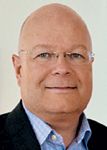
Tommy Söderman, General Manager Nordics, IPSEN
Tom Rönnlund, General Manager Nordic & Baltic Region for IMS, agrees that the industry faces serious challenges. "Austerity measures and efforts to reign in expenditures on pharmaceuticals are coupled to a longer-term trend of changing rules for the way in which pharmaceutical companies are expected to interact with the healthcare system. This concerns rules for meeting and interacting with care providers, how companies are able to arrange different kinds of activities for GPs, etc in the Nordics."

Tom Rönnlund, General Manager Nordic & Baltic Region, IMS
But this increased scrutiny also offers an opportunity to the international industry. "The change process, especially regarding the evolving business models, has been going on in the Nordics for a little bit longer than in other markets," Rönnlund said. "That allows the industry to be slightly ahead of the game. Many companies have also used the Nordic markets for piloting innovative approaches to act in the best possible way in this environment."
Part of the key to success is realizing that traditional sales models no longer work. "The times are over that you have a detailed aid and sell something—that does not fly anymore," said Markku Santonen, general manager Nordic & Baltic, Amgen. "You need to understand the medicine and the value the medicine can add to a certain group of patients."
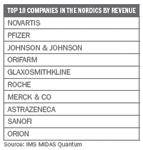
TOP 10 COMPANIES IN THE NORDICS BY REVENUE
Amgen adapted its organization and tactics in the region to meet the new environment. "It used to be more about demand generation; this is no longer the case in Scandinavia. We need to combine the market access, health economics, and the commercial part. It is not easy, but it is the way in which the Nordics as a group are moving," Santonen concluded.

Markku Santonen, General Manager Nordic & Baltic, Amgen
Is the 'Nordic model' really the key explanation behind the remarkable success of the Danish and Swedish life sciences industry? In Denmark, cooperation between government and industry is praised by both sides, and it is safe to say that it supported the industry's focus on the long-term and on niche areas such as diabetes, CNS or allergy.
In Sweden, the situation is more complex. Although the government has set up a solid framework for innovation to thrive and to support the life sciences industry, satisfactory cooperation often seems to be lacking.

Morten Nielsen, CEO, NNE Pharmaplan
"There are good initiatives in Sweden," said Rönnlund. "But they sometimes feel a little bit like a late wake-up call. Only when AstraZeneca shut down a big chuck of its research operations in Sweden the government hurried to drum up plans and policies around innovation. The Danish government and their ambitions, working together with the pharmaceutical industry association and other players, are slightly more concrete."
But the Nordic model is first and foremost cross-country partnerships like the Medicon Valley Alliance which facilitate the convergence of technologies, clever networking and the consolidation of niches in which the Nordics display a strong heritage. "That is the process we are in now—building up beacons, or areas with one shared headline in which we combine different strongholds and disciplines," Jørgensen concludes. As the Swedish band ABBA would probably say, take a chance on the Nordics.
